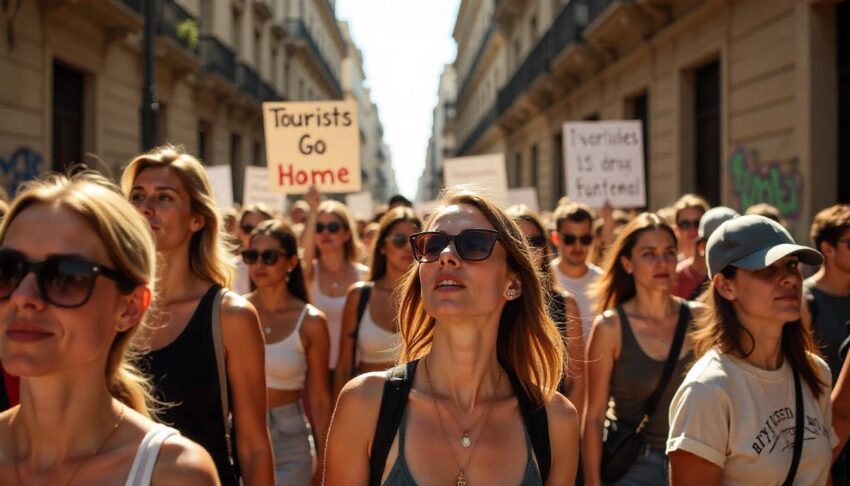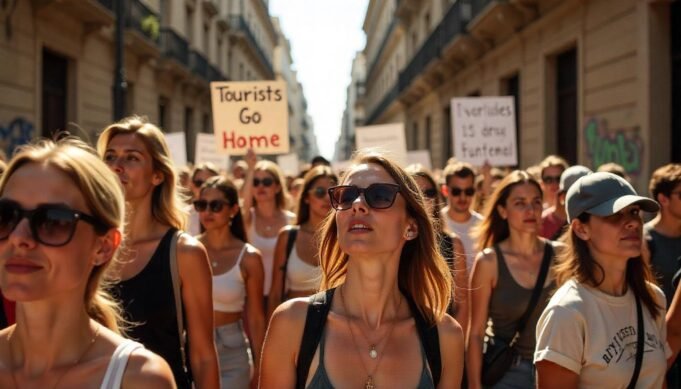Wednesday, July 9, 2025

Mexico marches hand in hand with Spain, Italy, France, Portugal, and others in rising protests against American and British visitors, a historically unprecedented shift in worldwide travel tensions that visitors need to grasp now. From Mexico City to Mallorca, Venice to Lisbon, residents are standing en masse in outraged protest—calling for immediate tourism restrictions, condemning gentrification, and accusing visitors from the United States and United Kingdom of pushing up rents, pushing out people, and turning formerly livable cities into congested playgrounds. These synchronized protests, now spreading across continents, are part of a rising trend that no longer values mass tourism as a positive good but as a nuisance—and what you should know now is that the backlash is no longer local, but worldwide.
Mexico: Protests Against Tourism Resurge in
It boiled over this weekend in Mexico City as foreign visitors and Mexicans clashed. Thousands of demonstrators filled the streets, particularly around aging working-class neighborhoods such as Roma and Condesa—now trendy digital nomad and expat hubs. A sign reading, “Gringos, stop stealing our home,” and “Pay taxes, learn Spanish, respect my culture” was waved by demonstrators. Demonstrators also marched on public Metro stations and the U.S. Embassy as symbolic centers of foreign influence.
The demonstration, though initially calm, descended into mayhem when masked protesters started smashing storefronts, looting shops, and insulting visitors. The outcry is a testimony to broad-based angst about gentrification. In the wake of 2020 pandemic lockdowns, tens of thousands of American expats have moved to Mexico, frequently taking advantage of a positive exchange rate and cheaply priced rent. Between 2019 and 2022, the U.S. Department of State documented a 70% increase in American residents in Mexico, taking the figure to over 1.6 million by 2024.
Tourist arrivals reflect this longer presence. In 2024, approximately 45 million foreign visitors came to Mexico, of which 25 million were American nationals—making America by a good margin the single largest tourist market. In the first four months of 2025, Mexico had 7.86 million arrivals by air, Americans once again dominating by a substantial margin. Resentment among native populations has risen, as natives believe American visitors and retirees drive up rents, displace original residents, and redefine local lifestyle and culture while not necessarily contributing to the economy.
Spain: British Invasion Stirs Island-Wide
Across the Atlantic, Spain has been another center of protest against tourism. On the main land and on the Balearic Islands, residents have been increasingly vocal against what they view as out-of-control tourism and prioritizing tourist interests over residents’ concerns. In June 2025, thousands of residents in Mallorca, Barcelona, and Tenerife have taken to the streets to protest increased costs of living, deficiencies of housing, and overcrowding of public services by mass tourism.
Protesters carried signs reading “Tourism kills the city,” “Your holidays, our misery,” and indeed used water guns to spritz visitors walking through jammed streets as a form of “cooling them down.”
Spain is still one of the most-traveled countries globally, and British visitors are its largest tourist demographic. In 2024, the nation hosted approximately 18 million UK visitors and a considerable amount of the 40.2 million American visitors who came to Europe during that year. Even though American arrivals to Spain for that particular year were not disaggregated, Spain is still one of the leading European tourist destinations among American citizens.
During Q1 2025, 17.1 million international tourist arrivals were achieved by Spain, a growth rate of 5.7% compared to the previous year’s quarter. 3.1 million arrivals came from British visitors alone, a testament to the magnitude of the travel tidal wave that is stretching Spanish cities to their limits.
Italy: Venice and Rome Push Back Against Cultural Erosion
Italy is resisting, too. In Venice, a city already grappling with increased sea levels and mass tourism, protests broke out in early 2025 as residents demanded a high-profile wedding reception hosted by billionaire Jeff Bezos be moved. In response to the initiative titled “No Space for Bezos,” organizers of the party had no choice but to relocate the event. Protests asserted public spaces and the historical heritage of the city were being conceded for foreign oligarchs.
In 2024, over 3.4 million tourists from the United Kingdom visited Italy, while American tourism continued to rebound rapidly, especially in cities like Rome, Florence, and Milan. Though Italy’s national statistics for U.S. arrivals in 2024 are still being finalized, prior patterns suggest the country welcomed several million American visitors as well.
The authorities in Italy have started to adopt measures to control the crowds, such as restricted access to particular historical areas, tour group restrictions, and time-specific entries at major tourist sites like the Colosseum and Vatican Museums.
France: Paris and Cannes Draw the Line
France, also, has entered the fray of protest and tourism regulation. In Cannes, local authorities have imposed restrictions on cruise liners, seeking to cap the number of daytime passenger disembarkations. The luxury-traveler and A-lister-magnet city announced that it would no longer become a turning point for mega-cruise vessels from 2026 onward—a decision made to reduce crowding, pollution, and pressure on urban infrastructure.
France welcomed over 6.38 million UK tourists in 2024, along with a substantial number of American visitors. Paris remains one of the top destinations globally for U.S. travelers, especially during major international events. In anticipation of the 2024 Olympic Games, the city implemented new rules restricting Airbnb listings and added urban toll zones to discourage heavy vehicle use.
France’s anti-tourist sentiment is not only targeted at numbers, but at visitor quality and their footprint on a culture as well, as locals have been criticizing what they call “Instagram tourism” and disrespect from visitors.
Portugal: Lisbon and Porto Require a Pause
Portugal, though smaller than its neighbors, has not escaped the tourism storm. Lisbon and Porto, the two primary destinations, have experienced sharp increases in foreign property ownership and short-term holiday rentals, leading to skyrocketing housing prices. In response, residents have held demonstrations, demanding legislation to curb real estate speculation and preserve residential zoning.
In 2024, Portugal received approximately 4 million British tourists, with American visitors also growing in number. While U.S. arrival data is less frequently published, travel from the States to Portugal rose sharply post-pandemic as more Americans sought affordable and culturally rich destinations. With infrastructure now under pressure, Portuguese officials are considering tourist taxes, Airbnb caps, and housing protections for locals.
The Bigger Picture: From Welcome Mats to Warning Signs
The rising protest movement connecting Mexico with Spain, Italy, France, Portugal, and beyond is no longer merely about saving heritage—it’s about taking back cities from mass tourism’s commercializing forces. Once a haphazard form of street protest, this is increasingly becoming a global discussion regarding whose cities these are and how much local authorities should do to safeguard their people from the cultural and economic strains induced by overtourism.
At its heart are American and British visitors—those visitor populations that always fall among the largest visitors to these countries. Long periods of stay, consumption, and cultural insensitivity have elicited a breaking point among residents, particularly in localities now gentrified by digital nomads and transient foreign residents.
Protest across countries:
- Location: Mexico City (Condesa, Roma, metro stations, U.S. Embassy)
- Date: July 4–7, 2025
- Details:
- Hundreds protested mass tourism and gentrification.
- Signs read “Gringos, stop stealing our home.”
- Protest escalated—storefronts vandalized, tourists harassed.
- Cause: Anger over digital nomads and U.S. expats pricing out locals.
Spain
- Location: Mallorca, Barcelona, Valencia, Ibiza, Tenerife, Málaga, San Sebastián
- Date: June 15, 2025 (major coordinated protests)
- Details:
- Thousands marched with water pistols, smoke bombs, banners.
- Slogans included “Tourism kills the city.”
- Cause: Locals demand limits on short-term rentals and cruise ships.
Italy
- Location: Venice (also Milan, Naples, Genoa, Palermo)
- Date: Late June 2025
- Details:
- 700+ protesters held “No Space for Bezos” marches.
- Protests forced relocation of Jeff Bezos’s wedding reception.
- Cause: Anger over luxury tourism, cultural erosion, housing crisis.
France
- Location: Cannes, Nice, Villefranche-sur-Mer
- Date: June 29, 2025 (policy enacted)
- Details:
- Cannes bans cruise ships with over 1,000 passengers starting 2026.
- Limits disembarkation to 6,000 passengers/day.
- Cause: Environmental concerns, crowding, pressure on infrastructure.
Portugal
- Location: Lisbon, Porto, coastal zones
- Date: June 15, 2025
- Details:
- Protesters carried Saint Anthony effigy to protest luxury hotels.
- Demonstrations part of “Southern Europe Against Overtourism.”
- Cause: Housing unaffordability, displacement, short-term rental boom.
What Travelers Must Prepare For
Tourists from the U.S. and U.K. making travel plans for 2025 can anticipate increased rules, increased taxes, and potentially limited access to tourist favorites. Cities are rethinking short-term rentals policies, imposing new entry limits at heritage sites, and changing local taxes to support infrastructure improvements and preservation work.
But, beyond rule fine-tunings, the local mantra is absolute: visitors are fine—but not at community livelihood’s cost. Visitors are asked to comply with local custom, shop small, avoid overly touristy spots, and understand larger impacts of their visit.
TTW Founder and Editor in Chief Mr. Anup Kumar Keshan says: “It’s honestly shocking how, even with all these anti-tourism protests making international headlines, American and British tourists continue to flock to these destinations like nothing’s wrong. It’s not just a few angry locals anymore—it’s coordinated marches, growing unrest, and public demands for tighter laws. Yet tourism numbers keep rising as if the backlash doesn’t exist. There seems to be a real disconnect between the traveler’s experience and the daily reality for the people who actually live there. You’d think this level of protest would cause at least some pause, but instead, flights are full and short-term rentals are booming. If this continues, things might spiral even more—because locals are clearly saying they’ve had enough, and ignoring that message only builds more resentment. Responsible travel shouldn’t mean just seeing beautiful places—it should also mean respecting the people who call those places home.”
Mexico moves hand to hand with Spain, Italy, France, Portugal, and more as anti-tourism protests escalate in response to mounting local anger over the impact of American and British tourists—blamed for rising rents, overcrowding, and cultural disruption. This growing alliance signals a global shift as host nations push back against unsustainable tourism and demand urgent reforms.
The backlash is no longer anecdotal—Mexico and Europe’s tourism powerhouses are now in active revolt. The streets of Condesa, Barcelona, Venice, Lisbon, and Cannes are echoing with calls for reform. Tourists, especially from America and Britain, are no longer just visitors. In the eyes of many locals, they’ve become symbols of imbalance—and unless change follows, access to the world’s most beloved destinations may never be the same again.











